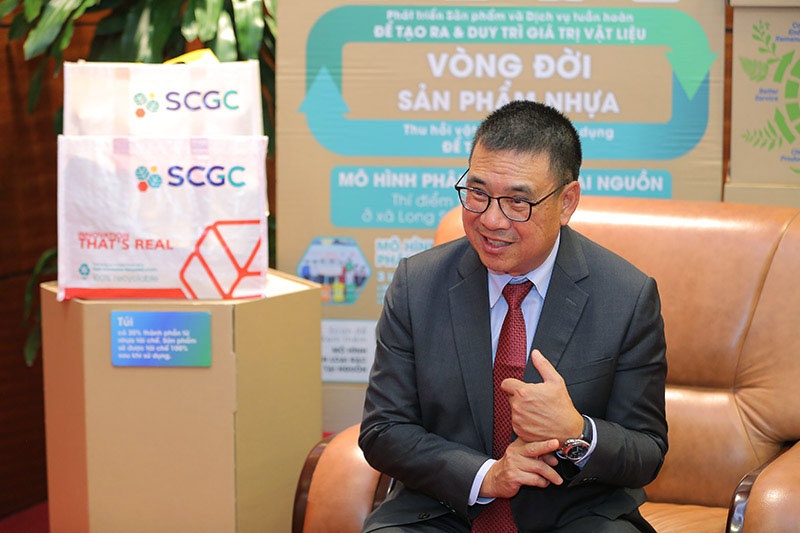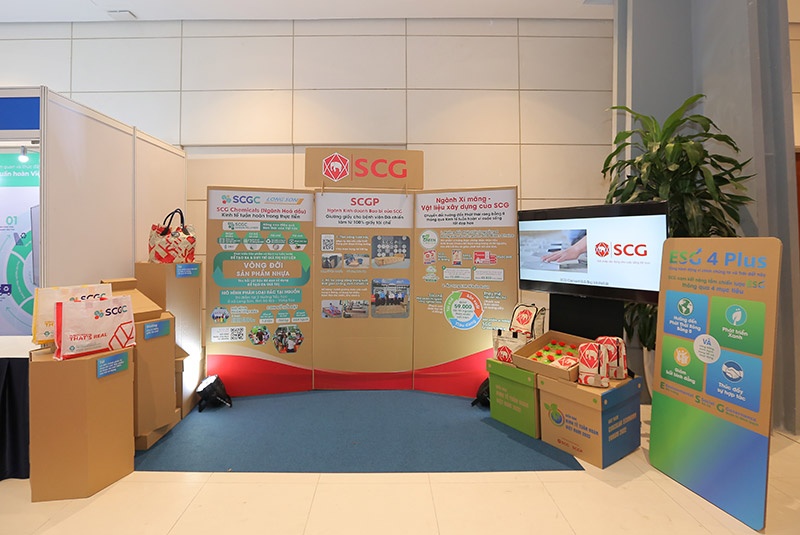Attempting to balance green ideas with profit
 |
| Roongrote Rangsiyopash, president and CEO of SCG |
What is the current state of the circular economy in Vietnam, and the role of the private sector in accelerating it?
I am so thrilled to see many developments here, and most importantly, it is encouraging to see the Vietnamese government’s commitment to sustainability. We all know that the development of physical infrastructure alone is no longer adequate, unless such development is combined with the advancement of human capital and commitment to sustainability and environmental protection.
A path to a low-carbon society, combined with development in the circular economy, leads to sustainable prosperity. Vietnam’s sustainability targets and the passing of the Law on Environmental Protection in 2020 emphasised the importance of international collaboration. Scientific data has suggested a strong correlation between climate change, global warming, and an increase in greenhouse gas emissions. At the same time, we are seeing the deterioration of natural resources and as economies recover, we are also experiencing a shortage of water and food.
With industrialisation and an increase in consumption, we are also facing major challenges in how to deal with waste. Ocean waste has threatened to destroy the ecological system and seabed. Unless we can properly sort, collect, recover, and recycle waste, we will not be able to overcome such challenges.
The government has made a commitment to become net zero by 2050. So we are quite pleased to see the commitment and now it’s time for action. From our standpoint, the role of the private sector is very important, because not only the government but also the private sector are participating in this because the private sector does manufacture and also creates emissions as well.
The objective of those companies is not only to do business, but also to become an important part of developing a sustainable future for the country and for society. So when we talk in terms of the private sector’s role in the circular economy, it is very important and should be the driving force for economic activities here.
We know that it is costly to develop the circular economy. How can businesses develop this way at an affordable level, and manage the costs to ensure their profits?
Some parts of the investment in the circular economy are very expensive, but on the other hand, we also realise that, when looking at the principle of the circular economy itself, it is pretty much based on balancing between consumptions and the resources that you use.
So, if looking at the overall programme of the circular economy, it’s a worthwhile investment. What we get is that we use the resources only as needed. We recycle and we reuse it at the same time, to save energy and resources from reprocessing.
This is where the market is moving, and where consumer sentiment is moving. It is very important in terms of sustainability that circular economy products and services are appreciated by people, and they appreciate it when a company makes the effort to move in this direction. So, on one hand, it is an investment, but on the other hand, if we really commit to it, surely it will pay off over the long run.
 |
| SCG wants to reach its own emission targets to help the wider global mission |
What are the biggest challenges for Vietnam to boost the circular economy?
The challenge is, particularly in Vietnam but in other countries as well, how to find a good balance between green sustainability while also making an economic impact. We’ve just recovered from the pandemic, and now we are being faced with inflation and high energy costs.
So we are not only dealing with the economic perspective, but at the same time, we have to start getting very serious in terms of the green and sustainable movement. That’s the first and probably most important challenge for a lot of countries, including Vietnam and Thailand. But we have learned valuable lessons during the past two years, and now we have to get a good balance between health and the economy moving forward.
How does SCG show commitment to net zero targets in Vietnam and apply it in manufacturing right now?
In order to achieve the net zero targets by 2050, our immediate target is to cut emissions by 20 per cent by 2030. This also aligns with ESG (environmental, social, and governance) strategy that SCG has been pursuing. So, that’s our commitment and we have a plan for this.
On one hand, we have plans which consist of a lot of actions to further use alternative energy and continue to invest in technologies that allow us to manufacture using much less energy. The second plan is Going Green, focusing on lower carbon-based products, for example, SCG Green Choice building materials that use much fewer emissions to manufacture.
Apart from that, our sustainable packaging innovations are helping customers to preserve the product better and are easy to recycle. The third one is in terms of reducing inequality. Basically, this can deal with enhancing the competencies of not only our employees but also how we can practice strong values within our people in the value chain.
And the last one is environmentalism and preserving nature, for example, by participating in projects to improve the ecological system and the country as a whole.
Circular economy allows us to focus more on three other factors. Firstly, we can reduce the use of natural resources and energy not only from a consumer standpoint but also from a manufacturing standpoint. Secondly, it is development of products that can be reused. That allows consumers to use products for quite some time and use it again, clean it, and then reuse it further. And the last one is recycling. For example, when we draw water from the environment, we recycle it and then reuse it. So the circular economy is a very good tool and a very good action plan for us to achieve low carbon emissions and the net zero commitment that we are making.
Moreover, a circular economy requires close collaboration between companies, customers, supply chains, and players along the value chains. We certainly can achieve more by working together. An example of such collaboration is the solid waste management project in the southern city of Vung Tau between SCGC (Chemicals Business of SCG) and the Ministry of Natural Resources and Environment, Vung Tau’s People Committee, The Alliance to End Plastic Waste, the Cities Development Initiative for Asia, and Innovation Norway.
What are your recommendations for the Vietnamese government to drive the transition towards the circular economy?
We have to get a good balance between the economy and sustainability. And it is very important that the government and the private sector collaborate, communicate, and make sure that they find some agreements in terms of the timeframe for transition and transformation into a greener society.
Businesses sometimes look for incentives, help, or some facilitation. So, if businesses understand and see clearly the path that the government is planning to take in terms of making those sources available, and coming from greener areas and renewables, they can make sure that their investment plan coincides well with the government’s plan. These challenges require the government and private sector to work together closely.
What the stars mean:
★ Poor ★ ★ Promising ★★★ Good ★★★★ Very good ★★★★★ Exceptional
Related Contents
Latest News
More News
- CONINCO announces new chairman and CEO (December 10, 2025 | 11:00)
- How AWS is powering the next-gen data era (December 09, 2025 | 13:14)
- Outlook in M&A solid for Singapore (December 08, 2025 | 10:31)
- Vietnamese firms are resetting their strategy for global markets (December 05, 2025 | 17:04)
- LPBank Securities accelerates AI and data innovation with AWS (December 05, 2025 | 09:00)
- Improving traceability capacity with Zebra Technologies (November 26, 2025 | 10:08)
- Ho Chi Minh City engages 500 CEOs in dialogue on building global megacity (November 25, 2025 | 16:00)
- CEO shares insights on Phu My 3 IP’s journey to green industrial growth (November 17, 2025 | 11:53)
- NS BlueScope CEO highlights decade of sustainable steel efforts (November 15, 2025 | 10:00)
- SCG maintains strong cash flow and drives low-carbon growth in Q3 (November 07, 2025 | 09:53)

 Tag:
Tag:





















 Mobile Version
Mobile Version